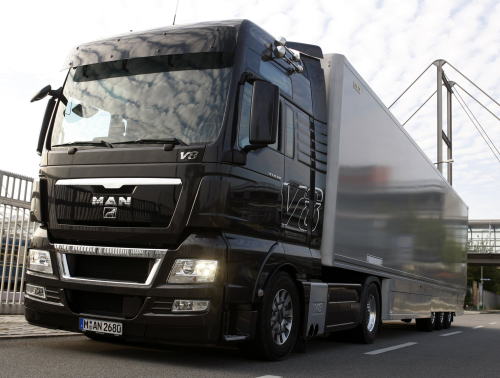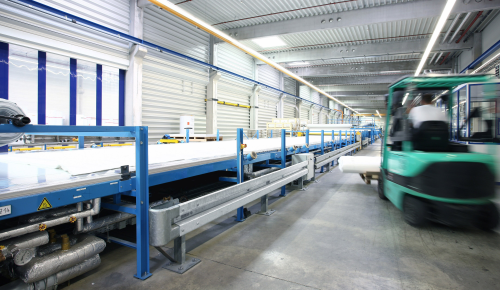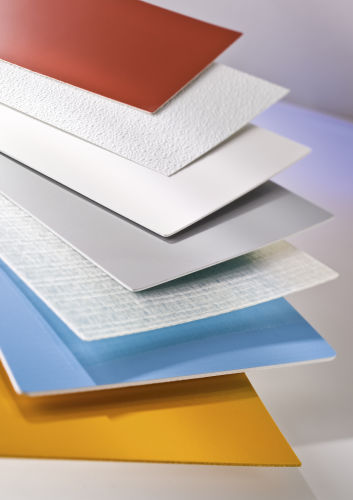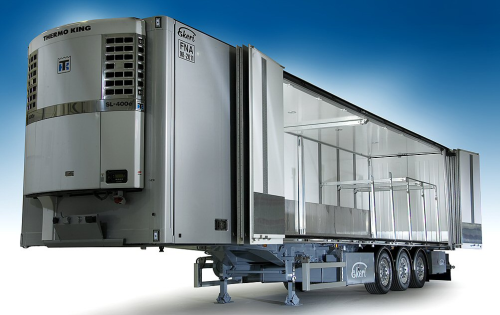




Energy efficiency and reducing carbon dioxide (C02) emissions are hot topics within the commercial vehicle industry. Operators want to reduce the tare or unladen weight of their vehicles. How can fibre reinforced composites make a difference?
Bachstein: Composites are an ideal material to incorporate into different sections of truck bodies and trailers. They can be used both as surface layers in sandwich elements for side walls and roof structures, as well as for flooring surfaces. We are talking about extremely sturdy, yet very lightweight materials, which result in reduced overall vehicle body weight due to their lightweight structure, which, in turn, leads to fewer emissions.
What makes composite materials so light and strong?
Bachstein: This is due to its basic structure. The composite material is a so-called laminate consisting of fibres and resin. The two components are brought together in a continuous production process. The two main parameters which determine the material’s physical and chemical characteristics are the type of fibre and the fibre arrangement (such as woven fabric or multiaxial fabric), and the kind of resin formulae used in production.
What advantages do composites have over other materials?
Bachstein: There are many advantages when comparing composites with conventional materials such as aluminium or sheet metal. First of all, strength and durability, characteristics which I mentioned earlier. The composite material firmly resists hail storms and even major mechanical impacts without any damage. If damage should still occur, even on a large scale, it is easily remedied. Moreover, fibre reinforced composites do not corrode, are weather-proof and UV resistant, all of which results in a long-lasting, pleasing appearance. The material is also food-safe, which means it can be used in refrigerated transportation.
What advantages can the commercial vehicle industry gain from fibre reinforced composites?
Bachstein: A vehicle’s tare or unladen weight can be reduced dramatically. Let me give you a few figures with regard to surface layers typically used in sandwich elements. Whereas steel 0.6 mm thick has an absolute weight of 4.7 kg per square metre, our 2.0 mm-thick fibre reinforced composite is just 2.7 kg. At 3.2 kg, aluminium 1.2 mm thick is also clearly heavier. This means with composites there can be a 40% reduction in body weight compared to steel and a 15% reduction in comparison to aluminium. What's more, due to the strong reinforcing effect in fibre reinforced composites, sandwich elements can have a thinner design.
The reduction in weight produces a direct benefit due to a higher loading capacity (i.e. a greater payload) and, consequently, lower transport costs as well as a decrease in fuel consumption.
How versatile are composite materials?
Bachstein: Our fibre reinforced composites are tailor-made according to specified requirements of the final product. We are thus well experienced in supplying the ideal material for all trailer components, such as different interior and exterior surface sheets for side walls and roof structures, and extremely firm, anti-slip coverings for floors. We can manufacture special variations for each of these sections, which are ideally matched to the loads and requirements of specific transport and logistics sectors.
Along with excellent physical and chemical properties, colour can be directly incorporated into the composite's upper gel-coat layer. Colours can be chosen from the RAL and NCS systems, or customised according to clients’ requirements.
What is the advantage of a solid-coloured gel-coat layer?
Bachstein: This surface coating consisting of extremely high-grade pure resin makes subsequent painting unnecessary. As this layer has been chemically bonded with the composite material, it won’t chip like conventional paintwork. Surfaces don’t require immediate repainting even in the event of slight damage such as scratches or stone chipping as our composites won't corrode.
Are there any other uses for your material in day-to-day goods transportation?
Bachstein: Yes. Our material can be produced with a pore-free surface. This means it is very easy to clean, so it fulfils other hygiene requirements for food transportation or vending trucks in addition to those for food application certification.
Moreover, when combined with polyurethane (PU) or expanded polystyrene (XPS) foam in sandwich elements, our composites make good use of excellent heat insulation properties and excel in terms of low thermal conductivity when compared to materials such as steel or aluminium. Composite material enables refrigerated truck bodies or trailers to be built in such a way that the risk of thermal bridges in the joints between walls and floors is reduced significantly.
How do you ensure that composites maintain the properties you mentioned earlier on a long-term basis?
Bachstein: First of all, during the research and development stage, we carry out a series of intensive material checks, such as a salt spray test in accordance with DIN EN ISO 9227 to verify corrosion resistance, or a Xenotest to check UV resistance and colour fastness. Then, in the production stage, our self-developed continuous production system, where fibre reinforced composites are manufactured in an automated continuous infeed process, enables us to manufacture composites featuring a consistent quality which can be reproduced at any time.
Heinrich Strunz GmbH has been producing fibre reinforced composites and daylight systems made of plastic, glass and aluminium under the LAMILUX brand name for more than 50 years. The medium-sized company uses a continuous production process in its LAMILUXplan Fiber Reinforced Composites Division. LAMILUXplan supplies customers around the globe in a wide range of sectors, including the automotive and recreational vehicle industries, refrigerated store and refrigerated cell manufacturing and the construction industry. The company achieved a turnover of €111 million in 2008. Its head office is located in Rehau, Bavaria, Germany. LAMILUX Heinrich Strunz will be exhibiting at the COMPOSITES EUROPE 2009 trade show in Stuttgart, Germany, on 27-29 October – stand number 4/F71. |






